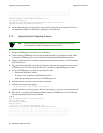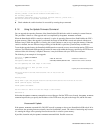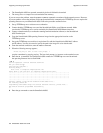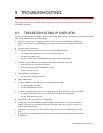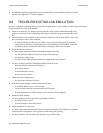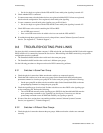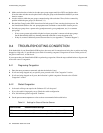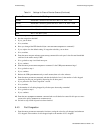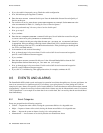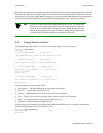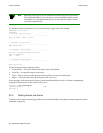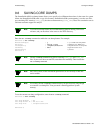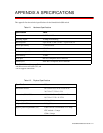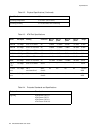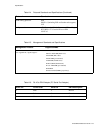9-6 SmartSwitch 6500 User Guide
Events and Alarms Troubleshooting
•
If yes, the switch is improperly set up. Check the switch configuration.
•
If no, this indicates port congestion. Continue.
2. Enter the show cacinfo command for this port. Note the bandwidth allocated for each Quality of
Service on this port.
3. For each class of service, enter the set porttrafficcongestion command. Set the MaxValue to the
value recommended in Table 9-1, “Setting for Class of Service Queues.”
4. Have you performed step 3 for every class of service for this port?
•
If no, go to step 3.
•
If yes, continue.
5. Enter the set caceqbwallocscheme command for this port. Set call admission control for this port
to a more conservative policy (
moderate or conservative).
6. Check VC statistics for this port using either the show pvc /d or show svc /d command, whichever
is appropriate. If the port belongs to the high virtual channel link (VCL), read the forward statistics.
If the port belongs to the low VCL, read the backward statistics. If the port belongs to both high and
low VCLs, read both statistics.
7. Is the number of cells received increasing?
•
If no, go through step 6 a few more times. If cells received still do not increase and congestion
persists, contact Cabletron Customer support.
•
If yes, continue.
•
Enter the show cacinfo command for this port. Is the Allocated Bandwidth less than the Cell
Reception Rate obtained from
show pvc /d or show svc /d in step 6?
•
If no, go through step 6 a few more times. If cells received still do not increase and congestion
persists, contact Cabletron Customer support.
•
If yes, this VC is misbehaving. Take appropriate action, for example, terminate the VC.
9.5 EVENTS AND ALARMS
The SmartSwitch 6500 switch records and reports its operation in real-time through the use of events and alarms. An
event is an occurrence of a significant activity. For instance, a port going down or a client joining an ELAN are
examples of events. Alarms are a specific class of events defined as “events that the user needs to know about or attend
to immediately.” Alarms do not always indicate switch faults. Alarms may also be informational events. For instance,
“LECS Operational” is an example of an alarm that is not a switch fault, but is an activity that the user should know
about immediately.
9.5.1 Event Categories
Events are grouped into the following categories:
•
Critical — Impacts the entire switch, leaving the system unavailable or in a degraded state
•
Major — Impacts a feature of the switch, leaving the feature unavailable or in a degraded state
•
Minor — Impacts the system or feature, leaving it in a sub-optimal state
•
Informational — An occurrence of an activity that the user should know about



